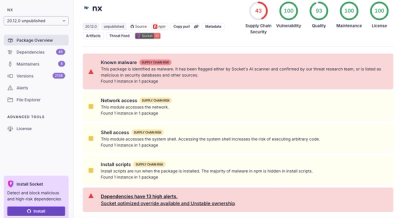
Security News
/Research
Wallet-Draining npm Package Impersonates Nodemailer to Hijack Crypto Transactions
Malicious npm package impersonates Nodemailer and drains wallets by hijacking crypto transactions across multiple blockchains.
plllayer provides a Ruby interface to an external media player, such as mplayer.
It takes a playlist to play (which may just be an Array of Strings containing the paths to the audio files), and lets you control playback as the playlist plays, with commands such as pause, resume, seek, skip, and so on.
$ gem install plllayer
Here's how to play your music library in random order:
$ irb
irb> require "plllayer"
=> true
irb> player = Plllayer.new(Dir["Music/**/*.{mp3,m4a,ogg}"])
=> #<Plllayer: ... >
irb> player.shuffle
=> true
irb> player.play
=> true
irb>
Then, while it's playing, you can type player.track to see what song it's playing, player.skip to skip to the next song, and so on.
Make a Plllayer like this:
player = Plllayer.new
This initializes a Plllayer with an empty playlist, and will use whatever external audio player is available on the system. You can also pass in an initial playlist, or specify what external audio player you want to use:
player = Plllayer.new(playlist)
player = Plllayer.new(external_player: :mplayer)
Only mplayer is supported at the moment.
A playlist is just an Array of tracks. A track is either a String containing the path to an audio file, or an object with a #location attribute that returns the path.
A singleton playlist, with only one track, doesn't need to be in an Array. That's ugly. You can just pass a track object to any method that expects a playlist and it'll understand.
To tell the Plllayer what playlist to play, either initialize the Plllayer with the playlist or use Plllayer#append:
player = Plllayer.new
player.append(playlist)
player << more_tracks # the << operator is an alias for append
The playlist can be accessed by Plllayer#playlist.
The playlist can be shuffled using Plllayer#shuffle:
player.shuffle
If one of the tracks is currently playing, it will be kept at the top of the playlist while the rest of the tracks will be shuffled.
The playlist can also be sorted:
player.sort
This delegates to Ruby's Array#sort, which sorts the tracks using their <=> method. This also means you can pass a block to compare tracks by, like this:
player.sort { |a, b| [a.artist, a.album, a.track_number] <=> [b.artist, b.album, b.track_number] }
This is safe to do when a track is currently playing, and then the next track that plays will be whatever comes next in the sorted playlist.
Lastly, the player's playlist can be reset to an empty playlist using Plllayer#clear:
player.clear
This stops playback if it's currently playing.
There are many commands that influence playback. Think of them as buttons on a physical media player: you can push them even when they don't apply to the state of the player. They always return false if this is the case, otherwise they return a truthy value.
See lib/plllayer.rb for all the available commands, with documentation.
FAQs
Unknown package
We found that plllayer demonstrated a not healthy version release cadence and project activity because the last version was released a year ago. It has 1 open source maintainer collaborating on the project.
Did you know?

Socket for GitHub automatically highlights issues in each pull request and monitors the health of all your open source dependencies. Discover the contents of your packages and block harmful activity before you install or update your dependencies.

Security News
/Research
Malicious npm package impersonates Nodemailer and drains wallets by hijacking crypto transactions across multiple blockchains.

Security News
This episode explores the hard problem of reachability analysis, from static analysis limits to handling dynamic languages and massive dependency trees.

Security News
/Research
Malicious Nx npm versions stole secrets and wallet info using AI CLI tools; Socket’s AI scanner detected the supply chain attack and flagged the malware.